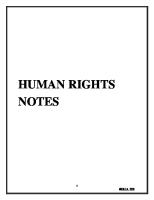Dark Arcana (Pamphlet), by Roland Volz [PDF]
1 Magic is manipulating reality with arcane symbols and mental exercise. There are several kinds of magical operation
39 0 131KB
Papiere empfehlen
![Dark Arcana (Pamphlet), by Roland Volz [PDF]](https://vdoc.tips/img/200x200/dark-arcana-pamphlet-by-roland-volz.jpg)
- Author / Uploaded
- Brenno Douglas
Datei wird geladen, bitte warten...
Zitiervorschau
1
Magic is manipulating reality with arcane symbols and mental exercise.
There are several kinds of magical operations. Each type is its own skill. Sample sorcery skills: Conjuring: can be used to either summon or banish entities from other dimensions. Exorcism: removing malign entities or magical effects from people or places. Geas: compelling certain behavior from people/entities. Glamour: distorting perception. Warding: magic of protection.
Magic is, by definition, outside of ordinary human ability. To know how well you do something magical, roll: One die if your occupational expertise is magical (so, Computational Demonologiests and Theoretical Thaumaturgists fail less often). One die if it’s within the sphere of one of your specific magical operation Skills or Talents. One die if there are elements that assist your magical operation (special supernatural equipment, the correct astrological factors for this kind of magic, and so on). Your Insanity die – magic in a Lovecraftian universe always involves risking your sanity. If your Insanity die rolls higher than any other die, make an Insanity roll, as per the usual Insanity rules. Your highest die shows how well you do. On a 1, you barely succeed. On a 6, you do brilliantly. When you perform, the highest die shows how effective your magic is. On a 1, you get something, but with major unintended consequences. On a 4, you get something serviceable, but with serious complications. On a 5, the complications are minor. Only on a 6 do you pull off a miracle – a pure magic feat that does exactly what it says on the label.
If someone thinks it would more interesting if you failed, they describe how you might fail and roll a die. Depending upon how difficult an action is deemed to be up to 3 fail die may be rolled (some things, like Sorcery, are inherently more dangerous and allow up to 5 dice to be rolled). A difficult action may only get 1 fail die whilst an impossible seeming one may get 3. 2
If their highest die rolls higher than your highest die, you fail, in the way they described. If not, you succeed as before, with your highest die showing how well you succeed.
Since you included your Insanity die in the roll, if you’re not happy with the result you may reroll (all the dice). Afterwards, look at the new result. As before, the highest die shows how well you do. If your Insanity Die rolls higher than any other die, make an Insanity roll, even if you made one after your previous roll.
To cooperate: everyone who is cooperating rolls their dice. The highest die, rolled by anyone, determines the outcome. To compete: everyone who is competing rolls their dice. Whoever gets highest wins. If it’s a tie, the person with highest Insanity wins. If Insanity is tied, reroll. As before, if your Insanity die rolls higher than any other die you roll, make an Insanity roll. And, if anyone is not happy with their roll, they may reroll, using the rules above – but if one rerolls, all have to reroll (magic is dangerous to everyone involved).
Your Injury starts at 1. When you are assaulted or suffer harm from misadventure, roll your Harm die. If you roll higher than your current Injury, add 1 to your rating and describe the harm you suffer. As your Injury increases, your Agent’s condition will worsen, and while they will eventually become numb to minor pains and bruises, they will still be quite vulnerable to more lethal wounds. When your Injury reaches 6, you die. Describe the bloody mess that is left of your Agent. Is your demise gruesome enough to disturb your fellows, forcing them to make Insanity rolls? You get to decide. Afterwards, make a new character. Briefly describe the Agent’s brush with the mythos and his induction into the Laundry. If you are attacked with melee weapons (small blades, clubs, etc.) or are involved in a brawl, roll your Harm die as normal, but make sure to appropriately colour your description based on the type of assault. If you suffer a dangerous attack or harm (handguns, car accidents, etc.), a Harm roll lower than your Injury adds 1, while a higher roll adds 2. With deadly attacks and harm (rifles, shotguns, machineguns, being hit by a speeding car, etc.), a Harm roll lower than your rating adds 2, while a higher roll adds 3. Anything more dangerous than that (hit by a train, explosions, etc.), and you will be dead outright.
3
Combat usually occurs between humans; however Agents can choose to engage with exonomes. Should they choose to try and engage with extremely powerful exonomes (essentially deities) they simply die, graphically. Everyone who’s fighting rolls dice. Agents roll: One die if it’s within human capabilities (if you’re using a gun, it is; if you’re using a spell, it isn’t). One die if you have a combat orientated Skill or Talent. One die if the creature is particularly vulnerable to your weapon. Your Insanity die, if you want. Now, start with the person who rolled highest. They choose someone to harm. (If it’s a tie, they both choose someone to harm and it happens simultaneously.) Next, the person who rolls second-highest chooses someone to take harm. And continue counting down, in order of highest die, but the person who rolls lowest doesn’t do harm. The above combat rolls are opposed. Humans get a single die to roll against an aggressor whilst mythos creatures and entities get between 3 to 4 at the Keeper’s discretion.
Cthulhu Dark is copyright © Graham Walmsley 2010. Dark Arcana was written by Roland Volz.
4









